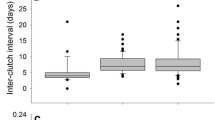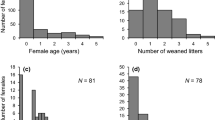Abstract
Seasonal fitness declines are common, but the relative contribution of different reproductive components to the seasonal change in the production of reproductive young, and the component-specific drivers of this change is generally poorly known. We used long-term data (17 years) on breeding time (i.e. date of first egg laid) in northern wheatears (Oenanthe oenanthe) to investigate seasonal reproductive patterns and estimate the relative contributions of reproductive components to the overall decline in reproduction, while accounting for factors potentially linked to seasonal declines, i.e. individual and habitat quality. All reproductive components—nest success (reflecting nest predation rate), clutch size, fledging success and recruitment success—showed a clear decline with breeding time whereas subsequent adult survival did not. A non-linear increase in nest predation rate caused nest success to decline rapidly early in the season and level off at ~80 % success late in the breeding season. The combined seasonal decline in all reproductive components caused the mean production of recruits per nest to drop from around 0.7–0.2; with the relative contribution greatest for recruitment success which accounted for ~50 % of the decline. Our data suggest that changing environmental conditions together with effects of nest predation have strong effects on the seasonal decline in fitness. Our demonstration of the combined effects of all reproductive components and their relative contribution shows that omitting data from later stages of breeding (recruitment) can greatly underestimate seasonal fitness declines.




Similar content being viewed by others
References
Arlt D, Pärt T (2007) Nonideal breeding habitat selection: a mismatch between preference and fitness. Ecology 88:792–801
Arlt D, Pärt T (2008) Post-breeding information gathering and breeding territory shifts in northern wheatears. J Anim Ecol 77:211–219. doi:10.1111/j.1365-2656.2007.01329.x
Arlt D, Forslund P, Jeppsson T, Pärt T (2008) Habitat-specific population growth of a farmland bird. PLoS One 3:e3006. doi:10.1371/journal.pone.0003006
Barbraud C, Rivalan P, Inchausti P, Nevoux M, Rolland V, Weimerskirch H (2011) Contrasted demographic responses facing future climate change in Southern Ocean seabirds. J Anim Ecol 80:89–100. doi:10.1111/j.1365-2656.2010.01752.x
Barton K (2012) MuMIn: multi-model inference. R-package, version 1.7.11. http://CRAN.R-project.org/package=MuMIn
Bates D, Maechler M, Bolker B (2012) lme4: Linear mixed-effects models using S4 classes. R package, version 0.999999-0. http://CRAN.R-project.org/package=lme4
Blums P, Hepp GR, Mednis A (1997) Age-specific reproduction in three species of European ducks. Auk 114:737–747
Both C, Visser ME (2005) The effect of climate change on the correlation between avian life-history traits. Glob Change Biol 11:1606–1613. doi:10.1111/j.1365-2486.2005.01038.x
Brinkhof MWG, Cavé AJ, Daan S, Perdeck AC (2002) Timing of current reproduction directly affects future reproductive output in European coots. Evolution 56:400–411
Brommer JE, Pietiäinen H, Kokko H (2002) Cyclic variation in seasonal recruitment and the evolution of the seasonal decline in ural owl clutch size. Proc R Soc Lond B 269:647–654. doi:10.1098/rspb.2001.1929
Brown CR, Brown MB (1999) Fitness components associated with laying date in the cliff swallow. Condor 101:230–245
Burnham KP, Anderson DR (2002) Model selection and multi-model inference—a practical information theoretical approach, 2nd edn. Springer, New York
Cabezas-Diaz S, Virgos E, Villafuerte R (2005) Reproductive performance changes with age and laying experience in the red-legged partridge Alectoris rufa. Ibis 147:316–323
Christians JK, Evanson M, Aiken JJ (2001) Seasonal decline in clutch size in European starlings: a novel randomization test to distinguish between the timing and quality hypotheses. J Anim Ecol 70:1080–1087
Conder P (1989) The wheatear. Helm, London
Cramp S (1988) Handbook of the birds of Europe, the Middle East and North Africa: the birds of the western Palearctic, tyrant flycatchers to thrushes, vol V. Oxford University Press, New York
Cushman JH, Boggs CL, Weiss SB, Murphy DD, Harvey AW, Ehrlich PR (1994) Estimating female reproductive success of a threatened butterfly: influence of emergence time and hostplant phenology. Oecologia 99:194–200
Daan S, Dijkstra C, Tinbergen JM (1990) Family planning in the kestrel (Falco tinnunculus): the ultimate control of covariation of laying date and clutch size. Behaviour 114:83–116
de Forest LN, Gaston AJ (1996) The effect of age on timing of breeding and reproductive success in the thick-billed murre. Ecology 77:1501–1511
Decker KL, Conway CJ, Fontaine JJ (2012) Nest predation, food and female age explain seasonal declines in clutch size. Evol Ecol 26:683–699. doi:10.1007/s10682-011-9521-7
Evans K, Leech D, Crick H, Greenwood J, Gaston K (2009) Latitudinal and seasonal patterns in clutch size of some single-brooded British birds. Bird Study 56:75–85. doi:10.1080/00063650802648291
Forslund P, Pärt T (1995) Age and reproduction in birds—hypotheses and tests. Trends Ecol Evol 10:374–378
Götmark F (2002) Predation by sparrowhawks favours early breeding and small broods in great tits. Oecologia 130:25–32. doi:10.1007/S004420100769
Hansson B, Bensch S, Hasselquist D (2000) The quality and the timing hypotheses evaluated using data on great reed warblers. Oikos 90:575–581
Hedgren S, Linnman Å (1979) Growth of guillemot Uria aalge chicks in relation to time of hatching. Ornis Scand 10:29–36
Hemborg C (1999) Sexual differences in moult-breeding overlap and female reproductive costs in pied flycatchers, Ficedula hypoleuca. J Anim Ecol 68:429–436
Hochachka W (1990) Seasonal decline in reproductive performance of song sparrows. Ecology 71:1279–1288
Low M, Arlt D, Eggers S, Pärt T (2010) Habitat-specific differences in adult survival rates and its links to parental workload and on-nest predation. J Anim Ecol 79:214–224. doi:10.1111/j.1365-2656.2009.01595.x
Martin TE, Scott J, Menge C (2000) Nest predation increases with parental activity: separating nest site and parental activity effects. Proc R Soc Lond B 267:2287–2293. doi:10.1098/rspb.2000.1281
Miller-Rushing AJ, Hoye TT, Inouye DW, Post E (2010) The effects of phenological mismatches on demography. Phil Trans R Soc Lond B 365:3177–3186. doi:10.1098/rstb.2010.0148
Morbey YE, Ydenberg RC (2000) Seasonal decline in nestling growth: support for the parental-quality hypothesis in Cassin’s auklets. Auk 117:1065–1068
Moreno-Rueda G (2004) Reduced parental effort in relation to laying date in house sparrows (Passer domesticus): a study under controlled conditions. Behav Process 67:295–302. doi:10.1016/j.beproc.2004.05.002
Naef-Daenzer B, Widmer F, Nuber M (2001) Differential post-fledging survival of great and coal tits in relation to their condition and fledging date. J Anim Ecol 70:730–738
Norris K (1993) Seasonal variation in the reproductive success of blue tits: an experimental study. J Anim Ecol 62:287–294
Ohgushi T (1991) Lifetime fitness and evolution of reproductive pattern in the herbivorous lady beetle. Ecology 72:2110–2122
Parsons J (1975) Seasonal variation in the breeding success of the herring gull: an experimental approach to pre-fledging success. J Anim Ecol 44:553–573
Pärt T (2001a) The effects of territory quality on age-dependent reproductive performance in the northern wheatear, Oenanthe. Anim Behav 62:379–388. doi:10.1006/anbe.2001.1754
Pärt T (2001b) Experimental evidence of environmental effects on age-specific reproductive success: the importance of resource quality. Proc R Soc Lond B 268:2267–2271. doi:10.1098/rspb.2001.1803
Pärt T, Wretenberg J (2002) Do artificial nests reveal relative nest predation risk for real nests? J Avian Biol 33:39–46
Perrins CM (1965) Population fluctuations and clutch-size in the great tit, Parus major. J Anim Ecol 34:601–647
Perrins CM (1970) The timing of birds’ breeding seasons. Ibis 112:242–255
Perrins CM, McCleery RH (1989) Laying dates and clutch size in the great tit. Wilson Bull 101:236–253
Plummer M (2003) JAGS: a program for analysis of Bayesian graphical models using Gibbs sampling. In: Proceedings of the 3rd International Workshop on Distributed Statistical Computing (DSC 2003), Austria, 20–22 March 2003. ISSN 1609-395X
Preston KL, Rotenberry JT (2006) The role of food, nest predation, and climate in timing of Wrentit reproductive activities. Condor 108:832–841
R Development Core Team (2012) R: a language and environment for statistical computing. R Foundation for Statistical Computing, Vienna. ISBN 3-900051-07-0. http://www.R-project.org/
Ricklefs RE (1969) An analysis of nesting mortality in birds. Smithson Contrib Zool 9:1–48
Roodbergen M, Klok C (2008) Timing of breeding and reproductive output in two black-tailed godwit populations Limosa limosa populations in the Netherlands. Ardea 96:219–232
Rowe L, Ludwig D, Schluter D (1994) Time, condition and the seasonal decline of avian clutch size. Am Nat 143:698–722
Saether BE (1990) Age-specific variation in reproductive performance of birds. Curr Ornithol 7:251–283
Salinas-Melgoza A, Renton K (2007) Postfledging survival and development of juvenile lilac-crowned parrots. J Wildl Manage 71:43–50
Schneider NA, Low M, Arlt D, Pärt T (2012) Contrast in edge vegetation structure modifies the predation risk of natural ground nests in an agricultural landscape. PLoS One 7:e31517. doi:10.1371/journal.pone.0031517
Schultz ET (1993) The effect of birth date on fitness of female dwarf perch, Micrometrus minimus (Perciformes: Embiotocidae). Evolution 47:520–539
Shustack DP, Rodewald AD (2011) Nest predation reduces benefits to early clutch initiation in northern cardinals Cardinalis cardinalis. J Avian Biol 42:204–209. doi:10.1111/j.1600-048X.2011.05231.x
Siikamäki P (1998) Limitation of reproductive success by food availability and breeding time in pied flycatchers. Ecology 79:1789–1796
Siikamäki P, Hovi M, Rätti O (1994) A trade-off between current reproduction and moult in the pied flycatcher—an experiment. Funct Ecol 8:587–593
Smith H (1993) Seasonal decline in clutch size of the marsh tit (Parus palustris) in relation to date-specific survival of offspring. Auk 110:889–899
Spear L, Nur N (1994) Brood size, hatching order and hatching date: effects on four life-history stages from hatching to recruitment in western gulls. J Anim Ecol 63:283–298
Sullivan KA (1989) Predation and starvation: age-specific mortality in juvenile juncos (Junco phaeonotus). J Anim Ecol 58:275–286
Tye A (1992) Assessment of territory quality and its effects on breeding success in a migrant passerine, the wheatear. Ibis 134:273–285
Verhulst S, Nilsson JA (2008) The timing of birds’ breeding seasons: a review of experiments that manipulated timing of breeding. Phil Trans R Soc Lond B 363:399–410. doi:10.1098/rstb.2007.2146
Verhulst S, Tinbergen J (1991) Experimental evidence for a causal relationship between timing and success of reproduction in the great tit Parus. m. major. J Anim Ecol 60:269–282
Verhulst S, Balen JHV, Tinbergen JM (1995) Seasonal decline in reproductive success of the great tit: variation in time or quality? Ecology 76:2392–2403
White GC, Burnham KP (1999) Program MARK: survival estimation from populations of marked animals. Bird Study 46:120–138
Winkler DW, Allen PE (1996) The seasonal decline in tree swallow clutch size: physiological constraint or strategic adjustment? Ecology 77:922–932
Acknowledgments
We thank all the field assistants for their invaluable help with collecting data on wheatears and all land owners allowing us to work on their land. We also thank the editor (Toni Laaksonen) and four anonymous reviewers for their valuable comments on previous versions. The study was funded by The Swedish Research Council VR (grants to T. P., D. A. and M. L.), FORMAS (grant to T. P. and M. L.) and the Swedish Royal Academy of Sciences (D. A.).
Author information
Authors and Affiliations
Corresponding author
Additional information
Communicated by Toni Laaksonen.
Electronic supplementary material
Below is the link to the electronic supplementary material.
Rights and permissions
About this article
Cite this article
Öberg, M., Pärt, T., Arlt, D. et al. Decomposing the seasonal fitness decline. Oecologia 174, 139–150 (2014). https://doi.org/10.1007/s00442-013-2763-z
Received:
Accepted:
Published:
Issue Date:
DOI: https://doi.org/10.1007/s00442-013-2763-z




